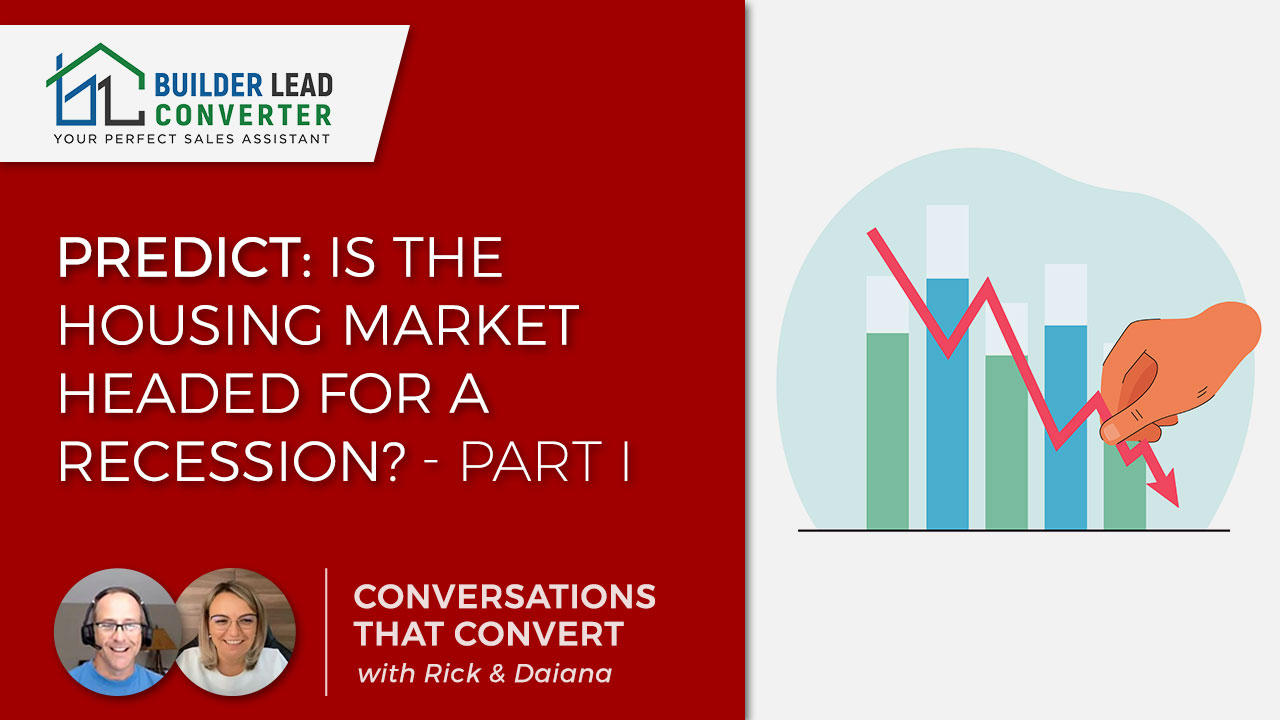Is your local housing market headed for recession?
After two years of incredible new home and remodeling demand, many home builders and remodelers are seeing a slowdown in their local markets. The US has now seen two consecutive quarters of negative GDP growth, which historically is the definition of a recession.
In our latest episode of Conversations that Convert, we discuss how to Predict if your local Housing Market is Headed for a Recession, and look at 3 of 6 key indicators builders can use to predict the impact of a recession on their local housing market.
Part I: 3 Key Indicators for Builders
So, what does this all mean for the housing market? In short, it’s complicated. There are a lot of factors influencing the market and it’s difficult to say exactly where it will go from here. However, we can make some predictions based on past trends and current economic conditions, and you can deep dive into those predictions by watching/listening to the episode below.
Builder Lead Lead Converter captures & converts leads for home builders & remodelers so they can grow sales revenue and margins. Find out how https://www.builderleadconverter.com/
Transcript:
Today on Conversations that Convert, we’re gonna try to predict if the housing market is in or headed for a recession. Let’s get started.
Welcome to conversations that convert every week, we’ll spend about 10 to 15 minutes tackling relevant lead generation marketing and sales topics for remodelers, home improvement companies, and home builders. Conversations that Convert is brought to you by builder lead converter, your perfect sales assistant.
And now here’s Rick and Daiana.
Rick: Hi, Daiana. Welcome. How are you today?
Daiana: Good. Good. Thank you. And you?
Rick: Well, night, it’s, I’m doing well. It’s a beautiful day here. I understand. You’re a little bit under the weather, so thank you for coming on anyway. And if you have to meet yourself today to cough, we’ll, we’ll understand why.
Daiana: Thank you for having me. Yes. It’s a pleasure to be here with you. So I don’t want to skip a, a, a session together.
Rick: We love, we love having you here.
Daiana: Yeah.
Rick: So, welcome everyone. Daiana, what are we talking about today?
Daiana: Today, we will predict, is the house in a market headed to a recession or not? So this is part one. So we love Elon Musk and his recipe. So we start to predict today.
Rick: That’s right. Yeah. This is all based on Elon Musk’s advice for companies that if you’re going through a recession, you wanna use this PPP strategy. So you predict first, then you prepare. And then you persevere. And of course, it’s all part of our series of builder’s guide to recession-proof your business. And this week, it, like as we mentioned before, this is part one. We’re gonna look at three of six key indicators that a builder can use to predict the impact of a recession on the local housing market. I wanted to before we jump into this, I want to emphasize local, very, very important that when you’re looking at this data, some of it is going to be national data. And that’s going to be reflected everywhere across the country. Some of it will be more local data, but the idea that I want everyone to walk away from is, that your market is going to handle a downturn differently than other markets. No, the two markets are really the same. So these six key indicators we’re gonna give you are just a way for you to look at what is the health of your current market, and what potentially could happen. And then you can put together a plan for preparing for that recession and then go ahead and persevere through it. So let’s just give the latest data that we have right now. The feds just came out. Oh yeah, the fed. So the feds just came out yesterday, Daiana, they raised interest rates and are three-quarters of a percent. So, we know that now, we’re waiting for the mortgage. The mortgage rates react to that, which is tied to the bond market. The other thing that just happened, here within the last 24 hours is that we have had a second consecutive quarter of negative GDP or gross domestic product growth. So from a technical standpoint, the last time this happened, the last 10 out of 10 times, this happened, we were in a recession. So I wanted, I don’t wanna get too hung up on definitions here because we already have the white house trying to spin it that, well, you know, this doesn’t mean that we’re in a recession. If people are hurting, if people feel like they aren’t able to afford a home or a remodeling project, people are scared about potentially losing their job. They’re feeling a downward cycle of consumer confidence that is going to affect your business. I think that’s really what we’re trying to get across here. So Daiana, anything you wanna add here before we jump into these key predictors?
Daiana: Oh, I’m, I’m looking forward to seeing the data. I’m a huge fan of data and the, and, looking forward to seeing that.
Rick: Yeah. So let’s jump into number one. Shall we?
Daiana: Yes.
Rick: Number one. All right. So our key predictor, our first one is mortgage rates. Now when the Fed raises interest rates, it doesn’t automatically affect the mortgage rate. Mortgage rates are different. The federal funds rate, of course, is the amount of money that banks charge to loan to one another. So if you have let’s, let’s say a home equity line, that interest rate that you borrow against is typically tied to the federal funds rate. So anybody that’s paying interest on a home equity line right now, their rate just went up three-quarters of a percent. Car loans are historically tied to this. So cars just got a whole lot more expensive to purchase. But mortgage rates do work off of the bond market. So it doesn’t necessarily mean that the mortgage rates are gonna follow this, but we’re gonna take a look here at just some, some data as it relates to mortgage rates and we’re gonna look at, okay. What has happened historically with mortgage rates? So this particular graph here tracks a 30-year fixed rate mortgage. We are also, tracking 15 years fixed rate mortgage, and then also a five, one-arm or adjustable rate mortgage, that adjusts every five, after five years, every year. So back going back to 1971, you can see a fixed rate mortgage was at 7.33%. This was the recession of the 1980s. We peaked at about 18.37% in 1981. Since then, since then interest rates have been falling. But what is interesting is that you have to get to about 2002 before interest rates get into the 5% range. So a lot of times you hear old timers, like me say, well, historically, Interest rates are quite good, even though they’ve gone up. they really didn’t hit 5% anytime in the last 50 years, until about 2002. But if you notice on this graph since about 2000, rates really haven’t gone much above 6%. They stayed around that 5, 6%, and then, of course, they bottomed. right around, for a 30-year fixed right around 2.88%, roughly September of 2021. and what happened since then is that rates have gone up pretty dramatically. So as of July 28th, today, rates are currently at 5.3%. So there are two things to take away from this today. Historically, yes, rates are pretty low. However, when you are dealing with a home buyer that has really only been in the home buying market since 2002 rates are considered high. That’s because they’ve since about 2002 rates have stayed around that 5 or 6%. The other thing that I want you to look at this is to look at the dramatic jump here in the last year. We’ve been up about two and a half percent in less, in less than a year. Now you have to go all the way back here to 1980, where you see a jump that big in 1980, here, it was about June 27th rates went from 12.35% to November 6th, 1981. So roughly a year and three months, they went up 6%, 6% in a year and three months. So we’re not on that same trajectory, but that’s the last time you see something, this steep. And of course, that was a huge recession. and, and, we’re looking at the same type of trajectory here. So I think the takeaway here, Daiana, is caution. We’ve seen rates go up. We, if they continue to go up at this type of trajectory, it’s going to put a lot of buyers outta the market and it already has, thoughts that you know?
Daiana: Yeah, I think it’s, it’s, it’s very good to see that in, in comparison with other years. So then you can, even if it’s, it’s getting higher, it’s not that higher. So like it, it was in back to eight.
Rick: Historic-historically. Right. It’s still a good rate. So if you have someone like me where I purchased my first home, back in the nineties, 1995. Yeah. I, my, my first-rate, I was in the eights and I took on an adjustable-rate mortgage, you know, back then. So. I was, you know, thought, Hey, I’m getting a good rate. So today, if I see 5.3% say, Hey, that’s not so bad, but really what it comes down to is yeah. Confidence, consumer confidence. If, if I’ve only been in the housing market since, in the last 20 years, I don’t know anything different than a low-interest rate. So that has a psychological effect. I mean, but the bottom line. if the cost of housing combined with the money, the mortgage rate that I have to borrow at the money I borrow at, if that is just above my affordability factor, I just personally can’t afford it. Yeah. Then I am not going to buy a home, you know, and I’m probably gonna pump the brakes and remodel the home as well. So that’s, that’s the first issue when I get across is that mortgage rates are really subjective based on who your target market is. The younger your target market, the more they’re gonna be affected by this. And secondly, it all comes down to affordability. As rates go up, affordability goes down and some people, even if they wanna buy a home or they wanna remodel their home, they’re not gonna be able to.
Daiana: I think that’s the actually the most important criteria because it, it, you, you look at, at the market, but at the same time, what’s the most important is to look if you afford that. So it doesn’t matter if it’s good, it’s a lower rate or, or higher rate on the market. What’s important is can, can I really afford that? Can I really answer this question? Yes. And then for, if not, it doesn’t matter what’s happening on the market.
Rick: And what we’ll talk about next week when we get into inflation is how inflation compounds. That, that problem, inflation, you know one thing to be able to make a mortgage payment. But it’s another thing is when your car payment goes up, the cost of your grocery is going up. The cost of energy goes, goes, goes up. All those things are gonna impact people and ultimately what they’re gonna be able to spend on their mortgage.
Daiana: Yep. That’s the second one.
Rick: So the second one is a key predictor number called home inventory. So home inventory, you do get national statistics on this, but national statistics do not matter. Inventory is local, always a local real estate market thing. So what I’m gonna show you right now is a spreadsheet that I put together, that I work with my clients and we track MLS data, on a 12, 6, and 3-month basis to determine how many months of inventory we have in the market. And then we look at how that affects our ability to make sales and also to make profitable sales. So if you look at this, down here, I have just some instructions on this. What we’re gonna do is we’re gonna determine the rate of sales and the level of inventory for your price point and product. So typically what you do is you might search for homes. If you’re a home builder, you might search for homes that are five years older and newer, depending on the model of homes in the market, in your area, you might only go back two years or newer or sometimes just something that’s labeled new construction. You just have to make that determination. Once you look at the data, I typically suggest searching as a 25 to $50,000 price spread. However, if you’re in a much higher price point, like say you’re a million plus you might search by a hundred, 200, $300,000 price spread. So lower your price point, the tighter the price spread. What we’re gonna do first to determine our rate of sales is we’re gonna look at the number of homes that have sold or have gone pending sale or sales are pending in the last 12 months. And then we’ll run the same scenario for 6 and 3 months. So this is what it looks like. I go into my MLS. I search for the type of homes I’m building, single-family association maintained. I look at the area that I’m building in. I look at the price range or the breadth of offering that I’m building. And then I look at homes that were built either five years old or newer. And I’m gonna say, see how many of those have either sold in the last 12 months or have gone pending in the last 12 months. And I’m gonna go ahead and fill this in here. And I’m gonna say, okay, let’s say, for example, I found that there were 9 sales and three pending. So 9 plus 3 is 12. So I’m gonna go ahead and put a 12 in there and you can see what’s happening here is that I say, okay, in the last 12 months of 12 homes are sold, I divide 12 homes. I divide that by the number of months, 12, and I get one sold per month. So if you look at the sales and pending, last 12 months, this shows us there’s been. Now I go back and I do this for 6 months. And so I say, okay, what’s happened since roughly, in 2022 since roughly February 1st of, of this year. So let’s say in the last 6 months there were, there were five, put that in here. So you see that’s a rate of sales of 0.83. And let’s say in the last 3 months, let’s just say there was one. That gives me an average rate of sales of 0.72. Now the next thing I do is go in and say, okay, how many homes are actively for sale in this price category? So I do my research, let’s say as an example. There are five homes actively for sale. I put five in there. So what this tells me is that based on the current rate of sales of 0.72 per month, I, with five homes on the market, will take 6.92 months to sell. So let’s look at some, some, notes here, a balanced market that’s not considered. The advantage of the buyer or the builder seller is typically 5 and a half to 6 and a half months of inventory. It’s considered a bouncing market. That’s where a new home can typically be priced 10 to 15% above a comparable used house or re-resale house. So five and a half to six and a half months, I typically, you know, just say average it out at six. So right now, if we look at this number here at 6.92 months, I’m considered a buyer’s market. That means it’s gonna put downward price pressure on me, on my homes. So as a general rule of thumb, you wanna avoid markets or change your product, or price point. If your inventories are over eight and a half months. One exception to that rule is if you have a high absorption or high inventory or traditionally used sales at a very low inventory of new homes, a lot of times you can out design a used house competition, meaning that if all the used houses in your price category, let’s say have a two car garage. And you build something with a three-car garage, that is going to differentiate yourself and people will be drawn to by, by your home besides the normal design trends and, you know, more lifestyle changes that you can make to your floor plans. So that’s the one exception to the rule, but if there’s lots of new construction that you’re competing with, this is where the red light should be flashing for something like this. what I, when we look at this again, we wanna avoid those markets again, where it gets eight and a half months. But right now it’s 6.2 months. If I’m talking to my client, I’m gonna say, look, we gotta pump the brakes. This is something we really need to take a closer look at. You use this sort of formula to try to find what we call a hole in the market. So where is that inventory under five and a half months? And can you build a product and hit that price point in that location in order to satisfy that demand in the market? Cuz right now that demand is being underserved. So last thing I’ll mention about this, Daiana is that historically when the, when the recession hits and the market slows down a lot of builders, their first inkling is that I need to reduce price, get my prices to here. But the problem is, is that a lot of people do that same thing, and everyone goes down to a certain price point and it floods the market. So now that market is actually worse. So sometimes you need to go up a price point, in order and because there’s less inventory there and there’s still a constant. You still may have to do some improvements to your home in order to get that home sold, but sometimes it’s better to go up than. Thoughts Daiana.
Daiana: Well, I, first of all, I love this formula. I’m wondering if you were able to share this because it’s, it gives clarity and it’s easy to use. And, again, when, when you, you, when you see them. Then you can decide faster. So I think it’s very valuable.
Rick: Yeah. And we will put a link for all the information here. If you’re watching this on YouTube, it’ll be in the description. If you’re watching it on our blog, we’ll put the link there on Facebook. We’ll do the, we’ll do the same thing. So we have one more key predictor. Yeah. To go over here today.
Daiana: Let’s look at that.
Rick: So buyer and builder confidence buyer and builder confidence is our third predictor. So what this looks like Daiana is we’re gonna go to the conf, conference board and we’ll add this to stream, and this is a board that tracks consumer confidence. And so if we look at this graph here, we will see this is consumer confidence going back to nine, or excuse me, 2006. And as you can see here in these gray lines, these are recession periods. So this was the great recession of 2008 to about, mid-2009. When we had the housing crash, then you could see confidence went up until we hit March of 2020. What happened in March of 2020? Daiana, do you remember? It’s been so long. Oh, I think we lost Daiana. She might have been, she might have lost her internet connection in March of 2020. That’s when COVID hit. And so, that’s where governments locked everybody down and of course, businesses shut down and consumer confidence plunged. So we actually had a short, short recession there. And then from there, it went back and forth, and then we had a big jump in confidence. From about 2020, till roughly mid-2021. But since that time in the last year, consumer confidence continues to go down and down and down. So this is certainly concerning. Consumer confidence goes down. That means that people are not gonna buy, they’re not gonna build. Let’s take a look at builder confidence. This is from the NAHB. So builder confidence plunges are afford-affordability woes mount. This is again, from July of this year. So builder confidence plunged in July is high inflation and high-interest rates stalled the housing market by dramatically slowing sales and fire traffic. Interestingly, look at this. Newly built single-family homes posted their seventh straight monthly decline in July falling. 12 points to 55. So for seven months now, basically every month this year builders have been saying, I don’t feel good about the future. I don’t feel good about the future. And of course, this sentiment comes from their frontline salespeople. What are they hearing buyers say? What does traffic count? Like what are sales like? So consumer confidence is down. Builder confidence is also down. The bottom line when it comes is that we have some real serious things to consider here as predicting a recession. The only thing of these three indicators that looks okay. Not good, but okay is interest rates, however, everything else is not looking good. Oh, welcome back, Daiana. So we were just, we were just no problem. We were just clarifying that of these three indicators. We’re just looking at the only one that looks okay is interest rates. But buyer and builder confidence does not look good. Home inventory may be okay. I’m tracking a lot of clients where inventory is going up month over month. And remember, once you hit that magical five and a half to six and a half month supply of inventory, that’s where you have a balanced market. Excuse me. And once it gets well above six, that’s where the related advantage is to the buyer. And you start to see prices going down and profitability going down for builders. So with that said, this doesn’t really tell us in your market what, if you’re going into a recession yet, however, nationally, some of these statistics are very concerning and I would definitely buckle your seat belt. Any other thoughts, Daiana, that you have?
Daiana: I think that’s very good advice. So, to just make sure that we, we have the cash, as you said last, last time and we are ready to face everything that wants to happen in the next period of time, but we, we don’t know. We try to predict, but actually, we don’t really know what’s going to happen.
Rick: Ex-excellent point. You know, I’m just giving you some tools to try to look at things from a data-driven perspective, but ultimately we do not know you’re, you’re so right. but if you would like to talk more about this, you know, looking at a recession, proofing your business and wanna schedule a strategy call, you know, find out how much time of yours that we can free up so you can focus on larger, more profitable jobs. What we have been focusing on now is helping builders manage leads. But now things are changing a little bit, and builders are asking us more like, Hey, I want to make sure I really got a solid process in place. So I’m not wasting any opportunities if, and when my market is going to tighten up. So that’s really the focus of more things we’re talking about here today. So we can definitely help you capitalize and not be at the whims of a bad market or recessionary housing. So my brothers and sisters in Christ made the grace of the Lord Jesus Christ. The love of God and the fellowship of the holy spirit, be with you all. We will see you next week for part two, where we’ll look at key indicators four through six. Bye, everybody. Bye Daiana.
Daiana: Bye.






Recent Comments